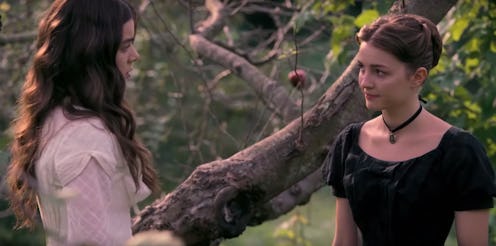Dickinson, the new costume-dramedy from Alena Smith, stars Hailee Steinfeld as the poet Emily Dickinson and Ella Hunt as Sue Gilbert, the object of her love. As a romance, it’s completely doomed. Sue is engaged to Emily’s brother Austin and, as we know from history, will marry him and move next-door. The idea that Emily was in love with her sister-in-law is more or less undisputed amongst scholars of the poet, though the precise nature of their relationship is far less certain. But where previous film and television attempts to depict Emily’s sexuality have mostly erred on the side of vagueness and even heterosexuality, Alena Smith’s entry is simultaneously clear and complicated.
Like her life, the details that surround Emily's relationship with her sister-in-law Susan Gilbert are hard to know. The two met in the late 1840s when Dickinson was 20 years old. They were intensely loyal correspondents, and over the 40 years following their meeting no one in Emily’s life was the recipient of more poems and letters than Sue. Emily called her Dollie. It was far from youthful crush. She’d known her for nearly twenty years, for example, when she wrote Susan this letter-poem:
To own a Susan of my own, Is of itself a Bliss — Whatever Realm I forfeit, Lord, Continue me in this!
Her letters were occasionally even more explicit: “Come with me this morning to the church within our hearts, where the bells are always ringing, and the preacher whose name is Love - shall intercede there for us!” No one can know for sure whether the love between them ever included sex, but most academics seem doubtful.
In Dickinson, Sue gives Emily an orgasm with her hand in Episode 2. They play and kiss and whisper. “I wish I could just marry you,” Emily softly pleads. It’s a departure from definitive history, but consistent with the Emily that Smith, a playwright and seasoned TV writer, is pushing in her debut as a showrunner. Smith’s Belle of Amherst isn’t a virginal recluse, but the wild, even bawdy, poet that her scholars recognize — a woman attacking life, clearing a path for her poems to walk through.
“I really trusted the scripts and Alena Smith because her knowledge of Emily Dickinson and Dickinson’s life,” Hunt tells Bustle of the revisionist history. “I read a lot of source material and essays, and there's a book called Open Me Carefully that kind of examines the letters that they wrote to each other. I trusted in the letters. And I read up a lot about female friendships and relationships in the 1800s. There were women that had sort of intense, romantic relationships, but we don't know whether they were sexual or not. But we do know that two women were able to live in a house together as lovers, unless a man came on the picture and was like, I need to marry you. But female friendship was, I think, viewed very differently in the 1800s, so I trusted in that and in the writing.”
For Sue and Emily, there will be no house to live out their days in and perhaps there never could have been. There is debate about whether Susan’s affection matched Emily in it’s fervor. But there are also moments like this, from an inscription Susan wrote in a gift book for Emily, after the poet had ceased to leave her house: “Emily, Whom not seeing, I still love.”
